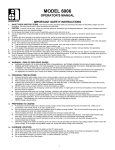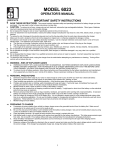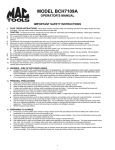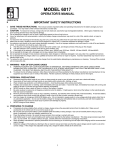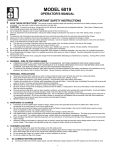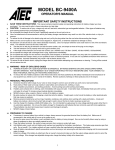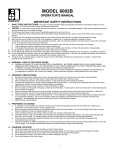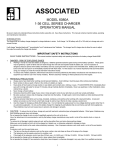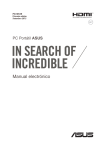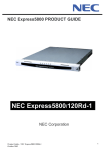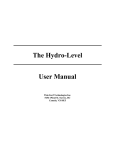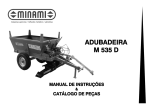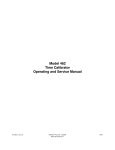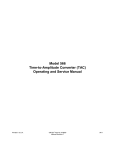Download Associated Equipment PP-1660D/U User's Manual
Transcript
MODEL PP-1660D/U 6/12/24V BATTERY CHARGER OPERATOR'S MANUAL IMPORTANT SAFETY INSTRUCTIONS 1. SAVE THESE INSTRUCTIONS. 12. WARNING - RISK OF EXPLOSIVE GASES This manual contains important safety and operating instructions for battery charger you have purchased. You may need to refer to these instructions at a later date. 2. CAUTION. To reduce risk of injury, charge only wet cell, lead-acid, automotive type rechargeable batteries. Other types of batteries may burst causing personal injury and property damage. 3. Do not expose the charger to rain or snow if specifically warned on the unit not to do so. 4. Use of an attachment not recommended or sold by the battery charger manufacturer may result in a risk of fire, electric shock, or injury to persons. 5. To reduce the risk of damage to the electric plug and cord, pull by the plug rather than the cord when disconnecting the charger. 6. Make sure the cord is located so that it will not be stepped on, tripped over, or otherwise subjected to damage or stress. 7. An extension cord should not be used unless absolutely necessary. Use of a improper extension cord could result in a risk of fire and electric shock. If an extension cord must be used, make sure: a. That the pins on the plug of extension cord are the same number, size, and shape as those of the plug on the charger; b. That the extension cord is properly wired and in good condition; and c. If the length of the extension cord is less than 25 feet, use a 14AWG cord, If 50 feet- 12AWG, 100 feet-10AWG, 150 feet-8AWG. 8. Do not operate the charger with a damaged cord or plug, replace them immediately. 9. Do not operate the charger if it has received a sharp blow, been dropped, or otherwise damaged in any way; take it to a qualified serviceman. 10. Do not disassemble the charger unless you are qualified to work on electrical products. If not, take it to a qualified serviceman when service or repair is required. Incorrect reassembly may result in risk of electric shock or fire. 11. To reduce the risk of electric shock, unplug the charger form the outlet before attempting any maintenance or cleaning. Turning off the controls will not reduce this risk. a. b. 13. PERSONAL PRECAUTIONS a. b. c. d. e. f. g. h. i. 14. b. c. d. e. f. If necessary to remove battery from vehicle to charge, always remove the grounded terminal from the battery first. Make sure all accessories in the vehicle are off, so as not to cause an arc. Be sure the area around the battery is well ventilated while the battery is being charged. Gas can be forcefully blown away by using a piece of cardboard or other non-metallic material as a fan. Clean the battery terminals. Be careful to keep corrosion from coming in contact with eyes. Add distilled water in each cell until battery acid reaches level specified by the battery manufacturer. This helps purge excessive gas from cells. Do not overfill. For a battery without cell caps, carefully follow the manufacturer's recharging instructions. Study all battery manufacturer's specific precautions such as removing or not removing the cell caps while charging and the recommended rates of charge. Determine voltage of the battery by referring to the car owner's manual and make sure that the output voltage selector switch is set at the correct voltage. If the charger has adjustable charge rate, charge the battery initially at the lowest rate. CHARGER LOCATION a. b. c. d. e. 16. Someone should be within range of your voice or close enough to come to your aid when you work near a lead-acid battery. Have plenty of fresh water and soap nearby in case battery acid contacts skin, clothing, or eyes. Wear complete eye protection, and clothing protection. Avoid touching eyes while working near battery. If battery acid contacts skin or clothing, wash immediately with soap and water. If acid enter eyes, immediately flood eyes with running cold water for at least 10 minutes and get medical attention immediately. NEVER smoke or allow a spark or flame in vicinity of the battery or engine. Be extra cautious to reduce risk of dropping a metal tool onto the battery. It might spark or short circuit the battery or other electrical parts that may cause an explosion. Remove personal metal items such as rings, bracelets, necklaces, and watches when working with a lead-acid battery. A lead-acid battery can produce a short circuit current high enough to weld a ring or the like to metal, causing a severe burn. Use this charger for charging a LEAD-ACID battery only. It is not intended to supply power to a low-voltage electrical system other than in an automotive application. Do not use this battery charger for charging dry-cell batteries that are commonly used with home appliances. These batteries may burst and cause injury to persons and damage to property. NEVER charge a frozen battery. PREPARING TO CHARGE a. 15. WORKING IN VICINITY OF A LEAD-ACID BATTERY IS DANGEROUS. BATTERIES GENERATE EXPLOSIVE GASES DURING NORMAL BATTERY OPERATION. FOR THIS REASON IT IS OF UTMOST IMPORTANCE THAT EACH TIME BEFORE USING YOUR CHARGER, YOU READ THIS MANUAL AND FOLLOW THE INSTRUCTIONS EXACTLY. To reduce the risk of battery explosion, follow these instructions and those published by the battery manufacturer and manufacturer of any equipment you intend to use in vicinity of the battery. Review cautionary markings on these products and on the engine. Locate the charger as far away from the battery as the DC cables permit. Never place the charger directly above the battery being charged; gases from the battery will corrode and damage the charger. Never allow battery acid to drop on the charger when reading the specific gravity or filling battery, Do not operate the charger in a closed-in area, or restrict ventilation in any way. Do not set a battery on top of the charger. DC CONNECTION PRECAUTIONS a. Connect and disconnect the DC output clamps only after setting the charger switches to the OFF position and removing the AC cord from the electric outlet. Never allow the clamps to touch each other. b. 17. Attach the DC clamps to the battery post and twist or rock back and forth several times to make a good connection. This tends to keep the clamps from slipping off the terminals and helps to reduce the risk of sparking. STOP/GO LITE INSTRUCTIONS When used properly, the STOP/GO LITE will indicate whether clamp connections will be correct. Connect the positive (red) clamp to the positive (POS, P, +) battery post. Touch the contact button of the negative (black) clamp to the other battery post. Observe the L.E.D. lights in the STOP/GO LITE: GREEN LIGHT: The first connection is correct. Make the second clamp connection per instructions. RED LIGHT: The first connection made with the positive clamp to the battery is incorrect. Attach the positive clamp to the other battery post and retest. RED AND GREEN LIGHT: The battery charger is turned on. Turn the charger "OFF" and retest. NO LIGHT: Check for a shorted or open battery. Clean any corrosion from the clamp jaws and the battery post and retest. If still no light, use a voltmeter or other means to make certain you have properly identified the polarity of the battery post. Then attach the clamps per instructions, disregarding the STOP/GO LITE. 18. FOLLOW THESE STEPS WHEN THE BATTERY IS INSTALLED IN A VEHICLE. A SPARK NEAR THE BATTERY MAY CAUSE A BATTERY EXPLOSION. TO REDUCE THE RISK OF A SPARK NEAR THE BATTERY: a. b. c. d. e. f. g. h. i. 19. FOLLOW THESE STEPS WHEN THE BATTERY IS OUTSIDE THE VEHICLE. A SPARK NEAR THE BATTERY MAY CAUSE BATTERY EXPLOSION. TO REDUCE THE RISK OF A SPARK NEAR THE BATTERY: a. b. c. d. e. f. g. h. 20. Read the section "STOP/GO LITE INSTRUCTIONS" before proceeding. Position the AC and DC cords to reduce the risk of damage by the hood, door, or moving engine parts. Stay clear of fan blades, belts, pulleys, and other parts that can cause injury to persons. Check the polarity of the battery post. The POSITIVE (POS, P, +) battery post usually has a larger diameter than the NEGATIVE (NEG, N, -) post. Determine which post of the battery is grounded (connected) to the chassis. If the negative post is grounded to the chassis (as in most vehicles), see item "e". If the positive post is grounded to the chassis, see item "f". For negative-grounded vehicles, connect the POSITIVE (RED) clamp from the battery charger to the POSITIVE (POS, P, +) ungrounded post of the battery. Touch the contact button of the STOP/GO LITE to the NEGATIVE (NEG, N, -) battery post. Interpret the light and take appropriate action. When the green light is on, connect the NEGATIVE (BLACK) clamp to the vehicle chassis, heavy gauge metal part of the frame, or engine block, away from the battery. Do not connect to the carburetor, fuel lines, or sheet metal body parts. For positive-grounded vehicles, connect the POSITIVE (RED) clamp from the battery charger to the POSITIVE (POS, P, +) battery post. Touch the contact button of the STOP/GO LITE to the NEGATIVE (NEG, N, -) battery post. Interpret the light and take appropriate action. When the green light is on, disconnect the POSITIVE (RED) clamp from the battery. Attach the NEGATIVE (BLACK) clamp to the NEGATIVE (NEG, N, -) ungrounded post of the battery. Attach the POSITIVE (RED) clamp to the vehicle chassis or engine away from the battery. Do not connect the clamp to the carburetor, fuel lines, or sheet-metal body parts. Connect to a heavy gauge metal part of the frame or engine block. When disconnecting the charger, turn the switches to OFF, disconnect the AC cord, remove the clamp from the vehicle chassis, and then remove the clamp from the battery terminal. See the operating instructions for length of charge information. Read section "STOP/GO LITE INSTRUCTIONS" before proceeding. Check the polarity of the battery post. The POSITIVE (POS, P, +) usually has a larger diameter than the NEGATIVE (NEG, N, -) post. Attach at least a 24 inch long 6-gauge (AWG) insulated battery cable to the NEGATIVE (NEG, N, -) battery post. Connect the POSITIVE (RED) charger clamp to the POSITIVE (POS, P, +) post of the battery. Touch the contact button of the STOP/GO LITE to the free end of the battery cable. If the red light comes on, reverse the connections to the battery and retest. When the green light come on, position yourself and the free end of the cable as far away from the battery as possible, then connect the NEGATIVE (BLACK) charger clamp to the free end of cable. Do not face the battery when making the final connection. When disconnecting the charger, always do so in reverse sequence of connecting procedure, and break the first connection while standing as far away from the battery as practical. A marine (boat) battery must be removed and charged on shore. To charge it on board requires equipment specially designed for marine use. GROUNDING AND AC POWER CORD CONNECTION INSTRUCTIONS The charger should be grounded to reduce the risk of electric shock. This charger is equipped with an electric cord having an equipment grounding conductor and a grounding plug. The plug must be plugged into an outlet that is properly installed and grounded in accordance with all local codes and ordinances. DANGER. Never alter the AC cord or plug provided - if it will not fit the outlet, have a proper outlet installed by a qualified electrician. Improper connection can result in a risk of an electric shock. This battery charger is for use on a nominal 120-volt circuit, and has a grounding plug that looks like the plug illustrated in FIGURE (A). A temporary adapter, which looks like the adapter illustrated in FIGURE (C), may be used to connect this plug to a two-pole receptacle, as shown in FIGURE (B), until a properly grounded outlet can be installed by a qualified electrician. DANGER. Before using an adapter as illustrated, be certain that the center screw of the outlet plate is grounded. The green-colored rigid ear or lug extending from the adapter must be connected to a properly grounded outlet - make certain it is grounded. If necessary, replace the original outlet cover plate screw with a longer screw that will secure the adapter ear or lug to the outlet cover plate and make ground connection to grounded outlet. NOTE: USE OF AN ADAPTER IS NOT ALLOWED IN CANADA. IF A GROUNDING TYPE RECEPTACLE IS NOT AVAILABLE, DO NOT USE THIS APPLIANCE UNTIL THE PROPER OUTLET IS INSTALLED BY A QUALIFIED ELECTRICIAN. 21. NOTE: SIDE TERMINAL TO BE USED IN POSITIVE CLAMP ONLY! to section 18 f or 18 g. For instructions for NEGATIVE clamp attachment refer Storage position Will not get lost. Always ready to use. 22. Extended position Note: Pressure, when handle is squeezed, holds adapter firm. Will not slip back. Thrust on terminal Note: Clamp is released and spring tension holds adapter firm. LENGTH OF CHARGE a. b. c. d. Test the battery for state of charge. Do not charge if it is over 75% charged or the battery is determined to be defective. Set beginning amps charge rate for size of battery and state of charge per charts Charge for length of time per charge, Discontinue charge when the specific gravity of electrolyte reaches 1.260 or above. A temperature compensating hydrometer should be used for this reading. Discontinue charge if the battery begins to gas excessively or when the temperature of the electrolyte reaches approximately 120EF. Do not overcharge batteries. Overcharging results in excessive water loss and eventual damage to the battery. ASSEMBLY INSTRUCTIONS Attach the handle to the charger using the four screws provided. Attach the front leg to the base with the four hex head screw provided. To attach wheels and axle to the base, tap one axle nut onto the axle with a hammer, slide one wheel onto the axle with the whitewall facing out, place one washer onto the axle, Push the axle through the base, place washer and wheel on opposite side. Tap axle nut onto the axle with a hammer. OPERATING INSTRUCTIONS CAUTION - This battery charger must be fully assembled before operating. Failure to do so may result in risk of injury. USE OF INSTRUMENT PANEL: The MINUTES CHARGE timer has an OFF position, a CONTINUOUS CHARGE position and a timed charge range from 0 to 90 minutes. a. OFF - Always make sure the timer is in the OFF position before connecting or disconnecting the clamps from the battery. The charger will not charge with the timer in this position. b. CONTINUOUS CHARGE - This position is used for slow charging or parallel charging and will not turn the charger off. Do not use this position for fast charging. c. 0 to 90 MINUTES TIMED CHARGE - The timer will automatically turn the charger off at the end of the pre-set charging time. d. VOLTS/AMPS CHARGE SWITCHES - These switches are used to regulate the output voltage and current of the battery charger. INITIAL CHARGE RATE SETTING BATTERY VOLTAGE AMPS CHARGE VOLTS CHARGE 6 LO 6V 12 LO 12V 24 LO 24V TO CHARGE BATTERIES Make connections to the battery per the instructions in preceding section of this manual. Determine the battery voltage and set initial charge rate settings per chart. Turn the timer on. If a higher rate of charge is desired, turn the AMPS CHARGE switch to the appropriate 2, 3 or HI position. Always return the AMPS CHARGE switch to LO position be fore advancing the VOLTS CHARGE switch. PARALLEL CHARGING This charger may be used to parallel charge up to 10 batteries with a bus bar kit, or by using a minimum 6AWG gauge booster cables to connect the batteries together in parallel. CAUTION: Do not connect 6 and 12 volt batteries in parallel with each other. WIRING DIAGRAM PP-1660D/U PARTS LIST Front leg . . . . . . . . . . . . . . . . . . . . . . . . . . . . . . . . . . . . . . . . . . Wheels w/nuts (2) . . . . . . . . . . . . . . . . . . . . . . . . . . . . . . . . . . . Axle w/nuts . . . . . . . . . . . . . . . . . . . . . . . . . . . . . . . . . . . . . . . . Transformer . . . . . . . . . . . . . . . . . . . . . . . . . . . . . . . . . . . . . . . Rectifier . . . . . . . . . . . . . . . . . . . . . . . . . . . . . . . . . . . . . . . . . . Fan Blade . . . . . . . . . . . . . . . . . . . . . . . . . . . . . . . . . . . . . . . . . Fan Motor . . . . . . . . . . . . . . . . . . . . . . . . . . . . . . . . . . . . . . . . . AC Circuit Breaker . . . . . . . . . . . . . . . . . . . . . . . . . . . . . . . . . . 605183 610091 605673 610396 610100 610189 610190 610397 Timer w/knob . . . . . . . . . . . . . . . . . . . . . . . . . . . . . . . . . . . . . . 610389 Switch w/knob . . . . . . . . . . . . . . . . . . . . . . . . . . . . . . . . . . . . . . 605675 Amps Charge Meter . . . . . . . . . . . . . . . . . . . . . . . . . . . . . . . . . 605204 AC Cord . . . . . . . . . . . . . . . . . . . . . . . . . . . . . . . . . . . . . . . . . . 605205 DC Cable Set . . . . . . . . . . . . . . . . . . . . . . . . . . . . . . . . . . . . . . 605207 DC Circuit Breaker (1) . . . . . . . . . . . . . . . . . . . . . . . . . . . . . . . 610069 Stop/Go Lite . . . . . . . . . . . . . . . . . . . . . . . . . . . . . . . . . . . . . . . 604579 Clamps (1 pair, includes jaws) . . . . . . . . . . . . . . . . . . . . . . . . . . . 6202 MAINTENANCE INSTRUCTIONS Worn clamps and jaws should be replaced. Worn parts can lead to poor connections and present a safety hazard. See parts list for part number of jaw and clamp kits. Any Maintenance or repair of this unit that involves disassembly of the cabinet should be done only by a qualified serviceman. Incorrect reassembly may result in a risk of electric shock when the unit is subsequently used. Service parts may be purchased from the factory by mail or phone. Minimum order from the factory is $25.00. Orders received that are under the minimum will not be processed. Taxes and freight are extra and are not considered to be part of the dollar value of the order. We do not have a C.O.D. policy. Cashier check, Money order, Mastercard or VISA are acceptable. If you use a Mastercard or VISA send only the number and expiration. DO NOT SEND THE CARD. ASSOCIATED EQUIPMENT CORPORATION 5004 BROWN AVENUE SAINT LOUIS MISSOURI 63115 (314) 385-5178 W2018 Rev.10/95 027-0567 PP-1660D/U ENGLISH MANUAL ILLUSTRATION LISTING 27-567E.MAN FIG. 1 2 4 5 6 7 8 FILE NAME STOP-GO.WPG PLUG-ENG.PLT SIDETERM.TIF ENGLSTBL.PLT 6001CAB.TIF A4586.PLT PARBAT.PLT DESCRIPTION STOP GO LITE ON BATTERY-ENGLISH GROUNDING ADAPTER -ENGLISH SIDE TERMINAL ADAPTER CHARGE RATE TABLE - ENGLISH 6001A CABINET PP-1660D/U TOP PANEL GRAPHIC PARALLEL BATTERY - ENGLISH 9 A4587.PLT PP-1660D/U WIRING DIAGRAM





